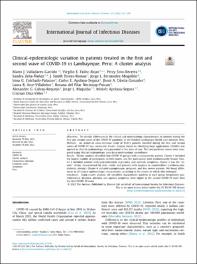Mostrar el registro sencillo del ítem
Clinical-epidemiologic variation in patients treated in the first and second wave of COVID-19 in Lambayeque, Peru: A cluster analysis
| dc.contributor.author | Valladares-Garrido, Mario J. | es_ES |
| dc.contributor.author | Failoc-Rojas, Virgilio E. | es_ES |
| dc.contributor.author | Soto-Becerra, Percy | es_ES |
| dc.contributor.author | Zeña-Ñañez, Sandra | es_ES |
| dc.contributor.author | Torres-Roman, J. Smith | es_ES |
| dc.contributor.author | Fernández-Mogollón, Jorge L. | es_ES |
| dc.contributor.author | Colchado-Palacios, Irina G. | es_ES |
| dc.contributor.author | Apolaya-Segura, Carlos E. | es_ES |
| dc.contributor.author | Dávila-Gonzales, Jhoni A. | es_ES |
| dc.contributor.author | Arce-Villalobos, Laura R. | es_ES |
| dc.contributor.author | Neciosup-Puican, Roxana del Pilar | es_ES |
| dc.contributor.author | Calvay-Requejo, Alexander G. | es_ES |
| dc.contributor.author | Maguiña, Jorge L. | es_ES |
| dc.contributor.author | Apolaya-Segura, Moisés | es_ES |
| dc.contributor.author | Díaz-Vélez, Cristian | es_ES |
| dc.date.accessioned | 2023-01-24T20:46:14Z | |
| dc.date.available | 2023-01-24T20:46:14Z | |
| dc.date.issued | 2022-07-18 | |
| dc.identifier.uri | https://hdl.handle.net/20.500.13053/7687 | |
| dc.description.abstract | “Objectives: To identify differences in the clinical and epidemiologic characteristics of patients during the first and second waves of the COVID-19 pandemic at the EsSalud Lambayeque health care network, Peru. Methods: An analytical cross-sectional study of 53,912 patients enrolled during the first and second waves of COVID-19 was conducted. Cluster analysis based on clustering large applications (CLARA) was applied to clinical-epidemiologic data presented at the time of care. The two pandemic waves were compared using clinical-epidemiologic data from epidemiologic surveillance. Results: Cluster analysis identified four COVID-19 groups with a characteristic pattern. Cluster 1 included the largest number of participants in both waves, and the participants were predominantly female. Cluster 2 included patients with gastrointestinal, respiratory, and systemic symptoms. Cluster 3 was the “severe” cluster, characterized by older adults and patients with dyspnea or comorbidities (cardiovascular, diabetes, obesity). Cluster 4 included asymptomatic, pregnant, and less severe patients. We found differences in all clinical-epidemiologic characteristics according to the cluster to which they belonged. Conclusion: Using cluster analysis, we identified characteristic patterns in each group. Respiratory, gastrointestinal, dyspnea, anosmia, and ageusia symptoms were higher in the second COVID-19 wave than the first COVID-19 wave“ | es_ES |
| dc.format | application/pdf | es_ES |
| dc.language.iso | eng | es_ES |
| dc.publisher | Elsevier Ltd | es_ES |
| dc.rights | info:eu-repo/semantics/openAccess | es_ES |
| dc.rights.uri | https://creativecommons.org/licenses/by/4.0/ | es_ES |
| dc.subject | COVID-19 Cluster analysis Coronavirus infection Pandemic wave Symptoms Peru | es_ES |
| dc.title | Clinical-epidemiologic variation in patients treated in the first and second wave of COVID-19 in Lambayeque, Peru: A cluster analysis | es_ES |
| dc.type | info:eu-repo/semantics/article | es_ES |
| dc.identifier.doi | https://doi.org/10.1016/j.ijid.2022.07.045 | es_ES |
| dc.type.version | info:eu-repo/semantics/publishedVersion | es_ES |
| dc.publisher.country | NL | es_ES |
| dc.subject.ocde | http://purl.org/pe-repo/ocde/ford#3.03.00 | es_ES |
Ficheros en el ítem
Este ítem aparece en la(s) siguiente(s) colección(es)
-
SCOPUS [380]


